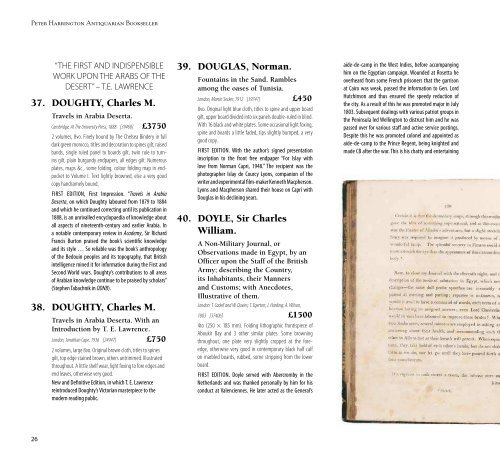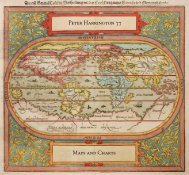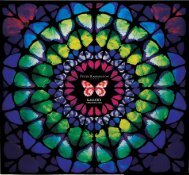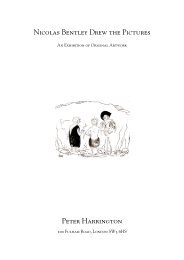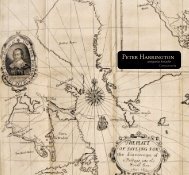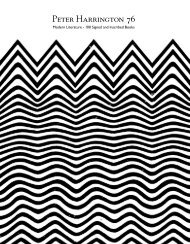antiquarian bookseller - Peter Harrington
antiquarian bookseller - Peter Harrington
antiquarian bookseller - Peter Harrington
Create successful ePaper yourself
Turn your PDF publications into a flip-book with our unique Google optimized e-Paper software.
<strong>Peter</strong> <strong>Harrington</strong> Antiquarian Bookseller<br />
“THE FIRST AND INDISPENSIBLE<br />
WORK UPON THE ARABS OF THE<br />
DESERT” – T.E. LAWRENCE<br />
37. DOUGHTY, Charles M.<br />
Travels in Arabia Deserta.<br />
Cambridge, At The University Press, 1888 [39460] £3750<br />
2 volumes, 8vo. Finely bound by The Chelsea Bindery in full<br />
dark green morocco, titles and decoration to spines gilt, raised<br />
bands, single ruled panel to boards gilt, twin rule to turnins<br />
gilt, plain burgundy endpapers, all edges gilt. Numerous<br />
plates, maps &c., some folding, colour folding map in endpocket<br />
to Volume I. Text lightly browned, else a very good<br />
copy handsomely bound.<br />
FIRST EDITION, First Impression. “Travels in Arabia<br />
Deserta, on which Doughty laboured from 1879 to 1884<br />
and which he continued correcting until its publication in<br />
1888, is an unrivalled encyclopaedia of knowledge about<br />
all aspects of nineteenth-century and earlier Arabia. In<br />
a notable contemporary review in Academy, Sir Richard<br />
Francis Burton praised the book’s scientific knowledge<br />
and its style … So reliable was the book’s anthropology<br />
of the Bedouin peoples and its topography, that British<br />
intelligence mined it for information during the First and<br />
Second World wars. Doughty’s contributions to all areas<br />
of Arabian knowledge continue to be praised by scholars”<br />
(Stephen Tabachnik in ODNB).<br />
38. DOUGHTY, Charles M.<br />
Travels in Arabia Deserta. With an<br />
Introduction by T. E. Lawrence.<br />
London, Jonathan Cape, 1936 [24947] £750<br />
2 volumes, large 8vo. Original brown cloth, titles to spines<br />
gilt, top edge stained brown, others untrimmed. Illustrated<br />
throughout. A little shelf wear, light foxing to fore edges and<br />
end leaves, otherwise very good.<br />
New and Definitive Edition, in which T. E. Lawrence<br />
reintroduced Doughty’s Victorian masterpiece to the<br />
modern reading public.<br />
39. DOUGLAS, Norman.<br />
Fountains in the Sand. Rambles<br />
among the oases of Tunisia.<br />
London, Martin Secker, 1912 [39741] £450<br />
8vo. Original light blue cloth, titles to spine and upper board<br />
gilt, upper board divided into six panels double-ruled in blind.<br />
With 16 black and white plates. Some occasional light foxing,<br />
spine and boards a little faded, tips slightly bumped, a very<br />
good copy.<br />
FIRST EDITION. With the author’s signed presentation<br />
inscription to the front free endpaper “For Islay with<br />
love from Norman Capri, 1948.” The recipient was the<br />
photographer Islay de Courcy Lyons, companion of the<br />
writer and experimental film-maker Kenneth Macpherson.<br />
Lyons and Macpherson shared their house on Capri with<br />
Douglas in his declining years.<br />
40. DOYLE, Sir Charles<br />
William.<br />
A Non-Military Journal, or<br />
Observations made in Egypt, by an<br />
Officer upon the Staff of the British<br />
Army; describing the Country,<br />
its Inhabitants, their Manners<br />
and Customs; with Anecdotes,<br />
Illustrative of them.<br />
London: T. Cadell and W. Davies; T. Egerton; J. Harding; A. Wilson,<br />
1803 [37406] £1500<br />
4to (250 × 185 mm). Folding lithographic frontispiece of<br />
Aboukir Bay and 3 other similar plates. Some browning<br />
throughout, one plate very slightly cropped at the foreedge,<br />
otherwise very good in contemporary black half calf<br />
on marbled boards, rubbed, some stripping from the lower<br />
board.<br />
FIRST EDITION. Doyle served with Abercromby in the<br />
Netherlands and was thanked personally by him for his<br />
conduct at Valenciennes. He later acted as the General’s<br />
aide-de-camp in the West Indies, before accompanying<br />
him on the Egyptian campaign. Wounded at Rosetta he<br />
overheard from some French prisoners that the garrison<br />
at Cairo was weak, passed the information to Gen. Lord<br />
Hutchinson and thus ensured the speedy reduction of<br />
the city. As a result of this he was promoted major in July<br />
1803. Subsequent dealings with various patriot groups in<br />
the Peninsula led Wellington to distrust him and he was<br />
passed over for various staff and active service postings.<br />
Despite this he was promoted colonel and appointed as<br />
aide-de-camp to the Prince Regent, being knighted and<br />
made CB after the war. This is his chatty and entertaining<br />
memoir of conditions in Egypt at the time of the defeat<br />
of the French, which includes a panorama of Aboukir Bay<br />
and a splendid plate of an officer of the Dromedary Corps.<br />
Catalogue 57: Travel Section 2: Africa and the Middle East to Persia<br />
2 2<br />
Atabey 360.<br />
41. DURNFORD, Anthony<br />
William.<br />
A Soldier’s Life and Work in South<br />
Africa. 1872–1879. A Memoir of<br />
the Late Colonel A.W. Durnford.<br />
Edited by his Brother, Lieut.-Colonel<br />
E[dward] Durnford, Part Author of<br />
the “History of the Zulu War and its<br />
Origin”.<br />
London, Sampson Low, Marston, Searle & Rivington, 1882 [39087]<br />
£975<br />
8vo. Original red decorative cloth, rebacked in red cloth with<br />
a tan morocco label. Mounted “Woodburytype” photograph<br />
portrait frontispiece and folding coloured map. Light<br />
browning, a couple of pages reinforced at the fore-edge, a few<br />
neat annotations to the text, map with one or two short splits<br />
A memoir<br />
of Egypt<br />
in 1803<br />
at the folds, one old paper tape repair verso, but overall very<br />
good, the cloth a little rubbed and spotted.<br />
FIRST EDITION. Uncommon account of Durnford’s service<br />
in South Africa, an apologia edited by his brother: “The<br />
court of inquiry into the loss of the camp duly attributed<br />
most of the blame for the defeat to Durnford’s rash<br />
conduct. This was hardly surprising since Chelmsford’s<br />
staff were determined to make Durnford the scapegoat<br />
for the disaster. His brother Lieutenant-Colonel Edward<br />
Durnford and Frances Colenso endeavoured through their<br />
writings and public lobbying to rehabilitate his reputation.<br />
They did not wholly succeed. Durnford’s heroic death did<br />
much to blunt public criticism of him, but there can be<br />
little doubt that his actions contributed materially to the<br />
disaster at Isandlwana. As Sir Theophilus Shepstone wrote<br />
of him, Durnford was ‘as plucky as a lion but as imprudent<br />
as a child’” (ODNB).<br />
Mendelssohn II, pp. 497–8.


